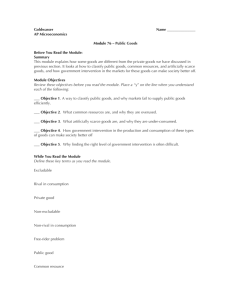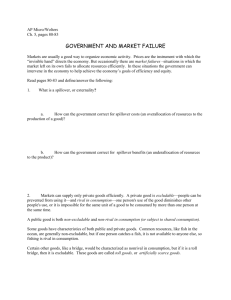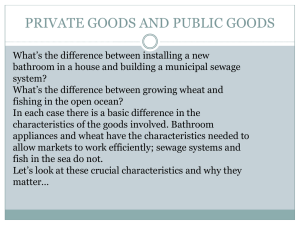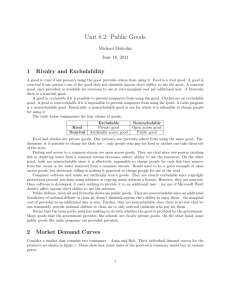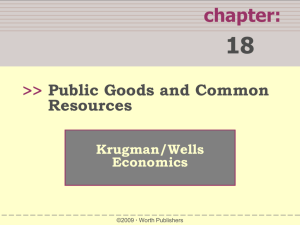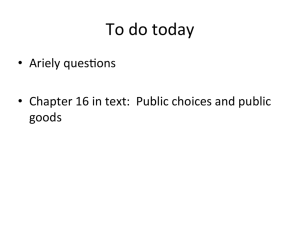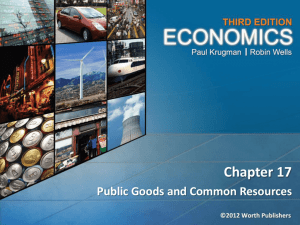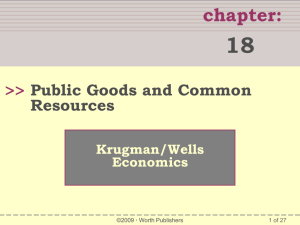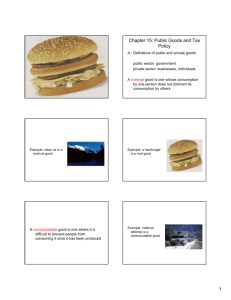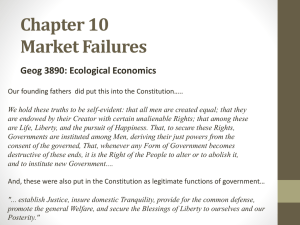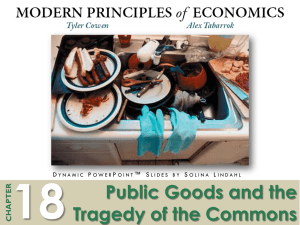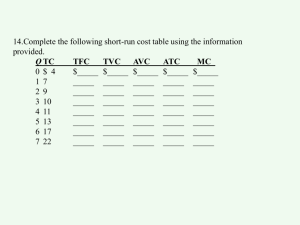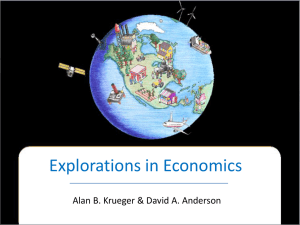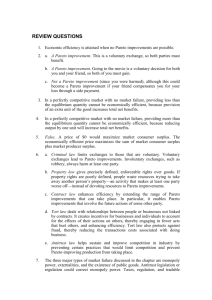Chapter 18 – Public Goods and Common Resources
advertisement
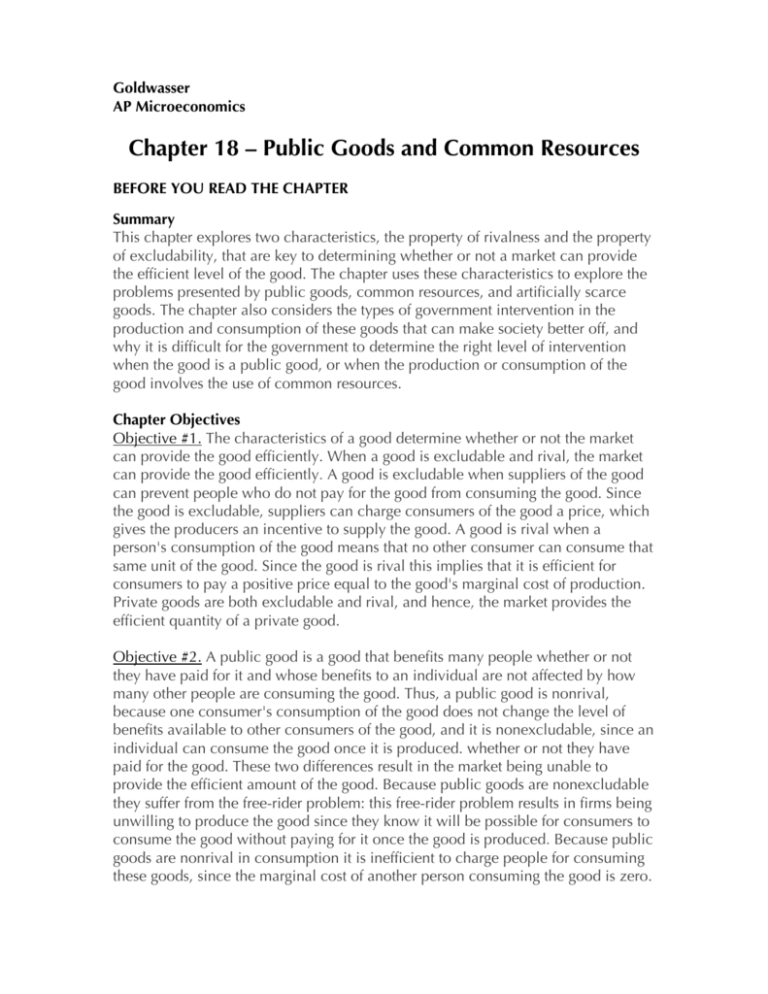
Goldwasser AP Microeconomics Chapter 18 – Public Goods and Common Resources BEFORE YOU READ THE CHAPTER Summary This chapter explores two characteristics, the property of rivalness and the property of excludability, that are key to determining whether or not a market can provide the efficient level of the good. The chapter uses these characteristics to explore the problems presented by public goods, common resources, and artificially scarce goods. The chapter also considers the types of government intervention in the production and consumption of these goods that can make society better off, and why it is difficult for the government to determine the right level of intervention when the good is a public good, or when the production or consumption of the good involves the use of common resources. Chapter Objectives Objective #1. The characteristics of a good determine whether or not the market can provide the good efficiently. When a good is excludable and rival, the market can provide the good efficiently. A good is excludable when suppliers of the good can prevent people who do not pay for the good from consuming the good. Since the good is excludable, suppliers can charge consumers of the good a price, which gives the producers an incentive to supply the good. A good is rival when a person's consumption of the good means that no other consumer can consume that same unit of the good. Since the good is rival this implies that it is efficient for consumers to pay a positive price equal to the good's marginal cost of production. Private goods are both excludable and rival, and hence, the market provides the efficient quantity of a private good. Objective #2. A public good is a good that benefits many people whether or not they have paid for it and whose benefits to an individual are not affected by how many other people are consuming the good. Thus, a public good is nonrival, because one consumer's consumption of the good does not change the level of benefits available to other consumers of the good, and it is nonexcludable, since an individual can consume the good once it is produced. whether or not they have paid for the good. These two differences result in the market being unable to provide the efficient amount of the good. Because public goods are nonexcludable they suffer from the free-rider problem: this free-rider problem results in firms being unwilling to produce the good since they know it will be possible for consumers to consume the good without paying for it once the good is produced. Because public goods are nonrival in consumption it is inefficient to charge people for consuming these goods, since the marginal cost of another person consuming the good is zero. Objective #3. A common resource is a good that many people consume whether or not they have paid for the good and whose consumption by each person reduces the amount of the good available to other people. The common resource is, thus, nonexcludable but rival in consumption since people can consume the good even though they have not paid for it, but their consumption of the good reduces the amount of the good available to others. Common resources are subject to overuse by individuals because individuals will continue to consume units of the good until their marginal benefit from consumption of the common resource is equal to zero. In choosing this level of consumption, individuals ignore the cost their actions inflict on society. Common resources thus present a problem of a negative externality in which individuals consume an inefficiently high amount of the good because they ignore, or fail to internalize, the external costs they impose on other members of society. In the case of a common resource, society must intervene in the market to find a way to get individual users of the resource to take into account the costs they impose on others. This intervention could be in the form of a Pigouvian tax, a system of tradable licenses for the use of the common resource, or through the assignment of property rights to the common resources. This last intervention, the assignment of property rights, gives the holder of the property rights the ability to limit the use of the common resource and, thus, prevent the overuse of this resource. Objective #4. Artificially scarce goods are those goods that are excludable but nonrival in consumption. These are goods that must be paid for in order for the consumer to consume the good but whose consumption does not diminish the ability of other consumers to consume the same unit of the good. Since the artificially scarce good is nonrival in consumption, the marginal cost of an individual's consumption is zero. When the supplier charges a price for this good, the price is therefore greater than the individual's marginal cost, which results in too few units of the good being consumed. The case of the artificially scarce good is similar to that of the natural monopoly in which the average total cost is greater than the marginal cost within the relevant output range. For both the artificially scarce good and the natural monopoly, the producers in these situations are willing to produce only if they can charge a price that is greater than the marginal cost of producing the good, but this price implies that the producer is producing an inefficiently low amount of output. Objective #5. When a good is either nonexcludable or nonrival, the market does not produce the efficient quantity of the good. • When a good is nonexcludable, this creates a free-rider problem in which consumers are not willing to pay for the good but instead want to free ride on those who do pay for the good. When consumers free ride, too little of the good is produced in the market. • When a good is nonrival in consumption, the cost of providing an additional unit of the good is zero because the good is nonrival. When consumers are forced to pay a price that is greater than zero, they end up demanding too little of the good and the market therefore produces an inefficient quantity of the good. Objective #6. A public good may be provided through voluntary contributions or by selfinterested individuals or firms who produce them with the hope of earning money through some indirect means. For example, broadcast television is produced by firms who earn money through advertisement rather than payments from consumers who watch the televised programming. A public good may also be provided through social encouragement or social pressure. Many public goods are provided by the government and funded through taxation. This provision of public goods by the government is a crucial role for the government: without government provision these public goods would either not be provided or would be provided at levels that are inefficiently low. Objective #7. Governments must decide whether or not to provide the public good and how much of the public good to provide. The optimal level of public good provision is the level where the marginal social benefit of the public good is equal to the marginal cost of producing the public good. In the case of a public good, the marginal social benefit from the public good is the sum of the individual marginal benefits that are enjoyed by all consumers of that unit. Since the public good is nonrival, the benefit an individual receives from the consumption of the public good does not diminish the benefit another individual receives from consuming the same unit of the public good. Therefore, the marginal social benefit from consumption of the public good is always greater than the marginal private benefit from the consumption of the public good: individual self-interest does not result in the provision of the efficient quantity of public goods because of this divergence between the marginal public and marginal private benefit from the consumption of the public good. This is similar to the problem presented by positive externalities: the market does not provide the efficient amount of the public good or the efficient amount of a good with a positive externality because the marginal social benefit received by all consumers of another unit of the good is greater than the price the producer would receive from providing that unit of the good. The market produces too little of either type of good. Objective #8. Governments decide on the optimal amount of the public good to provide by estimating the social benefits and the social costs of providing the public good. This process is known as cost-benefit analysis. Although it is relatively easy to estimate the cost of providing the public good, it is much more difficult to estimate the benefits from the provision of the public good. Individuals have an incentive to not answer truthfully about the benefits they receive from a public good because of the nature of the public good. Key Terms excludable referring to a good, describes the case in which the supplier can prevent those who do not pay from consuming the good. rival in consumption referring to a good, describes the case in which one unit cannot be consumed by more than one person at the same time. private good a good that is both excludable and rival in consumption. nonexcludable referring to a good, describes the case in which the supplier cannot prevent those who do not pay from consuming the good. nonrival in consumption referring to a good, describes the case in which the same unit can be consumed by more than one person at the same time. free-rider problem when individuals have no incentive to pay for their own consumption of a good, they will take a "free ride" on anyone who does pay; a problem with goods that are nonexcludable. public good a good that is both nonexcludable and non rival in consumption. cost-benefit analysis an estimate of the costs and benefits of providing a good. When governments use costbenefit analysis, they estimate the social costs and social benefits of providing a public good. common resource a resource that is nonexcludable and rival in consumption. overuse the depletion of a common resource that occurs when individuals ignore the fact that their use depletes the amount of the resource remaining for others. artificially scarce good a good that is excludable but nonrival in consumption. Notes AFTER YOU READ THE CHAPTER Tips Tip #1. This chapter looks at four types of goods-private goods, public goods, common resources, and artificially scarce goods-from the perspective of whether or not the good is rival in consumption and excludable. To understand this chapter, it is essential that you have a firm grasp on what it means to be rival in consumption versus nonrival in consumption and excludable versus nonexcludable. • When a good is rival, this means that one person's consumption of the good effectively prevents another consumer from consuming that same unit of the good. Hamburgers and ice cream cones are two examples of goods that are rival: when Sally eats her hamburger or her ice cream cone this means that Joe cannot eat the same hamburger or the same ice cream cone. Joe and Sally are rivals with regard to the consumption of the hamburger or the ice cream cone. • When a good is nonrival, this means that one person's consumption of the good does not prevent another consumer from consuming the same unit of the good. Sally and Joe can both enjoy the light from the lighthouse in their community without diminishing the consumption benefits received by the other person from their consumption of the same light. Sally and Joe are not rivals with regard to the consumption of the light from the lighthouse. • A good is excludable if a supplier can prevent someone from consuming the good if they do not pay for it. Sally can enjoy her fast-food hamburger only if she pays for it. The restaurant will exclude her from the consumption of the hamburger if she cannot first pay for the hamburger. Hamburgers are therefore excludable as well as rival. • A good is nonexcludable if a supplier cannot prevent someone from consuming the good if they do not pay for it. Residents of a community can benefit from a tornado warning siren even if they do not pay for this siren. It is impossible to exclude the nonpayers from the benefits of consuming this good even though they have not paid for it. Tip #2. To find the demand curve for a public good requires that you vertically sum the individual demand curves for this public good. In contrast to a private good for which the market demand curve is found by horizontally summing the individual consumer demand curves, the public good requires the vertical summation of the individual consumer demand curves. The private good is rival in consumption, so that when we find the market demand curve we essentially ask how many units do demanders want of this good at a particular price. We repeat this process for different prices until we have identified the market demand curve for the private good. The public good, in contrast, is nonrival in consumption. This means that the market demand for the public good at any quantity is equal to the sum of the prices individuals are willing to pay for this particular amount of the public good. This nonrival characteristic of public goods implies that the market demand for public goods is found by considering the sum of what people are willing to pay for each level of public good provision. Figure 18.1 illustrates this idea for a public good when there are two individuals in the market for this good: D1 represents the first person's demand for the public good, while D2 represents the second person's demand for the public good, and D3 represents the total demand for the public good.
